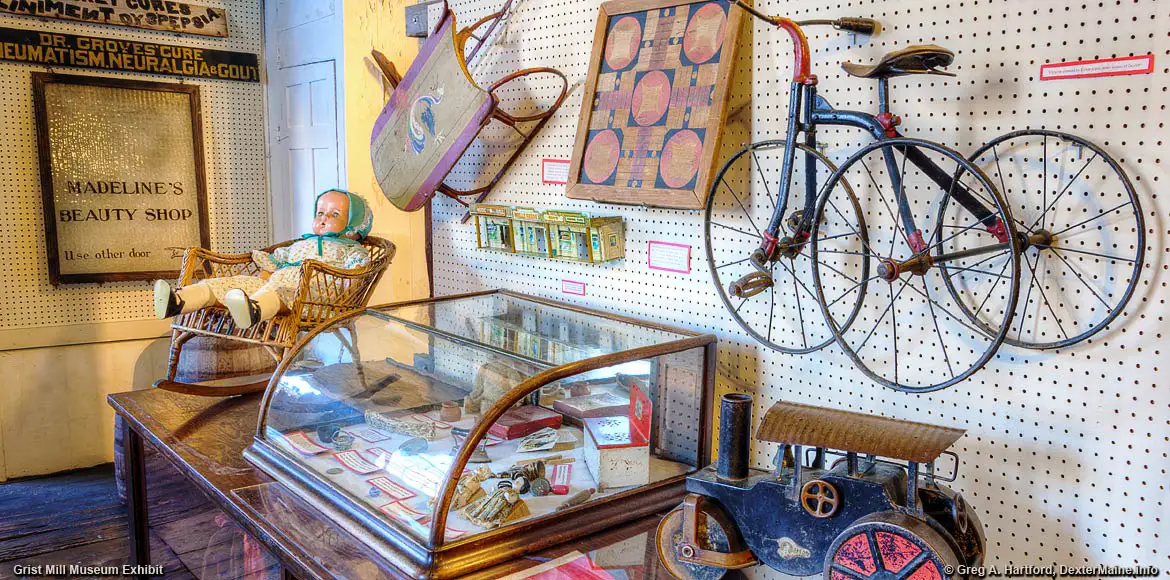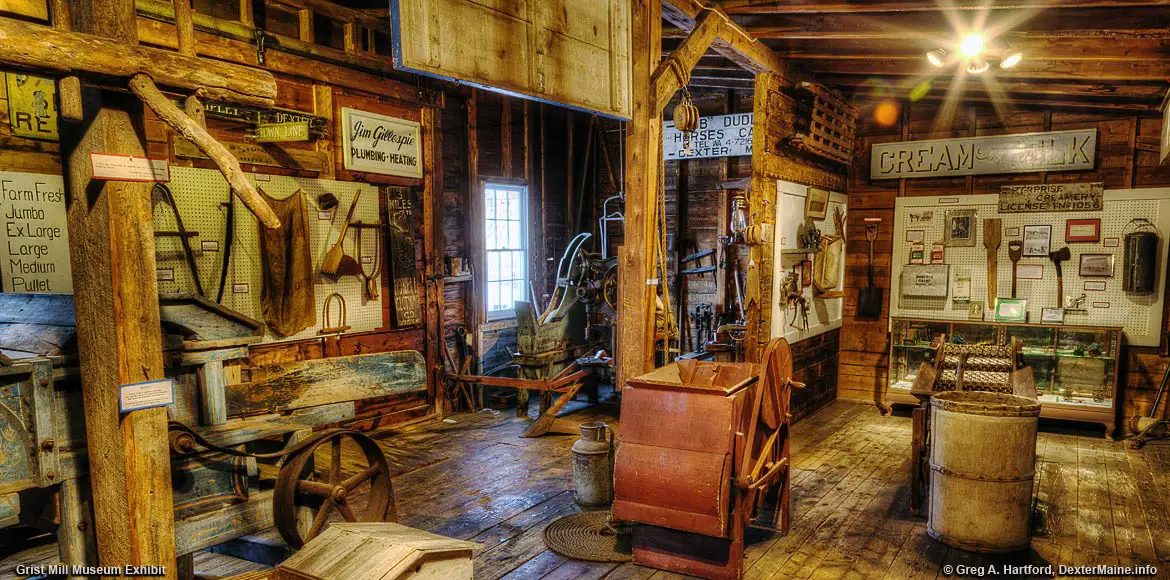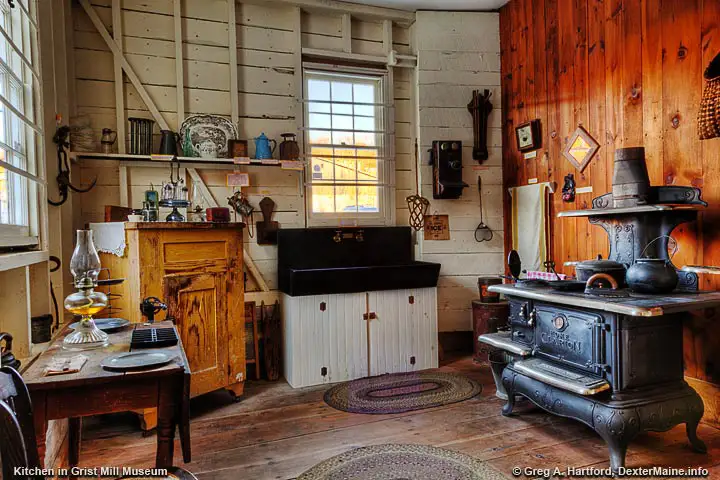Grist Mill Museum Campus
One of the most important businesses in any new town during the nineteenth and early twentieth centuries was a grist mill. People needed flour for baked goods and grain for the livestock. Without it, survival would be much more difficult. Grist mills of its time needed hydro power to operate and the place to be in Dexter was on the East Branch of the Sebasticook River right in the center of town. For 111 years, the S.L. Small Grist Mill was water powered. From 1854 through 1900, the grain was stone ground. Conveyor belts, also water powered, moved the grain inside the mill from its entry point, to grinding, then to storage at an elevated level, then back down to its delivery station. The mill finally closed operations in 1965 at the same time that the Dexter Historical Society was forming. The Town of Dexter agreed to acquire the building in 1966 and it became the first home of the Historical Society and its growing collection of artifacts. Given the importance that the Grist Mill played in Dexter’s history, it was fitting that the journey should begin here.
Open: Mid June - Mid Sept. Mon., Thurs., Fri. 10-4 pm; Sat. 1-4 pm
What is here?
When the grist mill was operational, agricultural areas from all around provided the corn, wheat and oats that would be ground to various degrees of fineness as was needed for baking as well as the course grain used to feed the animals. There are some who still remember the smells of the freshly ground grain or the taste of the breads and biscuits made from it. The current museum includes many permanent and changing exhibits reflecting different times in the community during the grist mill’s operation. These may cover home life, farming, agriculture, work or play. One such exhibit is of a period kitchen complete with a Monson slate sink, an old style crank phone, ice box, an old style wood cooking stove, and much more. There are parts of the grist mill still in view including the wheels, belts, elevators and grinding machine but not all are handicap accessible.
Home and Farm
There is a huge collection of historical artifacts in this collection, much more than one would realize. This was an impressive accomplishment by many dedicated individuals over many years time. Most all items are organized in displays throughout the Grist Mill. There are also several rooms opening to other things to explore and learn about. In the back is a large section with tools for both home and work, and farming and agricultural equipment. There is an excellently preserved horse drawn carriage, an old cheese & milk delivery vehicle (circa 1924), a milk operation and creamery, signs that hung on many of the businesses and public buildings. This is a journey through two hundred years of history as if it was a Time Machine!
History Rediscovered!
In each photograph shown on this page alone, there are numerous historic artifacts such as this one showing locally produced furniture from the 1800’s, tables, a large bed, wall hangings, a variety of items from local community organizations, an antique phonograph, period clothing, a collection of children’s toys, etc. Everywhere your eyes look, there is something else that will spark your curiosity or cause a flashback of something your remember seeing many years earlier. This is a great place to visit with family and friends, with your children, or even alone for some quiet reflection. After visiting, you will surely want to tell others about it. Please do!
The Miller's House 1825
The first time a grist mill was built at the current site was as early as 1818 and owned by Jonathan Farrar. Construction of the current building began in 1854 by Samuel Farrar (son of Jonathan) and Lysaner Cutler. There were several revisions and additions that followed over the generations that followed.
During the early years of operation, there was a small millpond on the eastern side of the mill where today, there is a municipal parking area. The miller and his family lived in a small cape (built 1825) on a bank on the opposite side of the millpond (to the East). This was simply referred to as the Miller’s House. It was moved to its current 5 Water Street location behind the Grist Mill next to the river in about 1855. This location has a china display, a Victorian style parlor, and historic photos of Dexter hanging on the walls.
Carr Schoolhouse 1845
Directly behind the Miller’s House at the Museum’s Campus is the one-room Carr Schoolhouse. This was built in 1845 about 3 miles away on the eastern side of town at the corner of the Carr Road and the Upper Garland Road to replace another one that had burnt down before. For many years after this, Dexter, Maine had 13 different separately run school districts! This was largely due to the roads and transportation being so poor. In 1876 a single town board took over the management of all of them but the same rural schools continued. As the roads and transportation improved, some of the rural schools were able to close. These rural schools were usually one-room and taught by a young single woman who had to board with some local family. The Carr Schoolhouse was moved to its new 7 Water Street location on the south side of the Miller’s House in 1998. It has a variety of artifact displays including furniture and photos.
Resources
- Grist Mill: 3 Water Street
- Miller's House: 5 Water Street
- Carr Schoolhouse: 7 Water Street
- Abbott Museum & Gift Shop:
12 Church St., (207) 924-5721
- Dexter Historical Society: (207) 924-5721
P.O. Box 481, Dexter, ME 04930 - Dexter, Maine Town Office: (207) 924-7351
23 Main Street, Dexter, ME 04930
Municipal Website
A Stunning Story of the Times
One of the most stunning stories was an account told by an early 1800’s student by the name of Maria Jennings. In her own words: “we had Master Norcross for several winters. Susan and Catherine Morgan [who lived on the Charleston Road in the Northeast Section of town but came down along a cross road] were two of my schoolmates, nice girls and good scholars, but poorer even than we were, for we always had one pair of shoes in a year, and they came to school all one winter with no shoes, only socks made of old cloth…. Our school books were Webster’s spelling book and the American Preceptor, English Reader, Columbian Orator, grammar and arithmetic.” These were rugged times!











